An Improved Indicator System for Evaluating the Progress of Sustainable Development Goals (SDGs) Sub-Target 9.1 in County Level
Abstract
:1. Introduction
2. The Problem of the Original Indicators of SDG Sub-Target 9.1 When Applied in County Level
- The requirements of the infrastructure itself. First of all, it should be able to withstand disasters and be sustainable; second, it should not only be able to be used in the region, but also capable to communicate with outside world, i.e., cross-border. In the end, it should be fair and accessible and affordable for everyone.
- Utility requirements for the transportation infrastructure construction. It should be able to support economic development, protect the basic life of the users, and have the potential to improve the quality of life of the users.
- 1.
- Indicator 9.1.1 focuses on the accessibility of rural populations, and it does not realize that rural areas are not the only one that has poor accessibility in many regions (especially those in low- and middle-income countries). In order to achieve the goal of poverty alleviation, rural areas should be the focus for consideration, because the access gap is indeed widespread in rural areas, and the construction of the transportation infrastructure is relatively less [10]. However, if the level of the transportation infrastructure construction of the whole region is determined by the accessibility of the rural population, it is implied that the level of the transportation infrastructure construction in non-rural areas (urban areas) is generally better than that in the rural areas. This seems undoubtful, but factually unreasonable. As shown in Figure 1, we can see that in the Xinshi Town, the sub-center city of Deqing County in the eastern part of Deqing (the red box), there is an area outside the buffer zone. We found in field investigations that the permanent residents in this area are not only the rural population, but also the urban population. Such a mixed rural and urban population area is not an exception in Deqing County, it is common in China and many other developing countries [16,17,18].
- 2.
- Indicator 9.1.1 has some difficulties in obtaining the data required for the calculation. In the calculation of the RAI indicator, the urban-rural boundary data is theoretically required to exclude the urban population from the calculation. However, in many counties, especially most of the underdeveloped regions, such data is generally lacking. In the case study of Deqing, the local management departments were also unable to provide us with good urban-rural boundary data.
- Eliminate the defects of the SDG sub-target 9.1, and establish an improved indicator system in accordance with the sub-target 9.1 requirements.
- Analyze the calculation results from the improved indicator system in Deqing County, and measure the advantage or disadvantage of the improved indicator system when applied in the county level.
3. Materials and Methods
3.1. Research Area
3.2. Methodology
- Data should be easily obtained or generated by less difficult methods;
- It should be applicable to county level applications;
- It should be easy to explain and can clearly convey its calculation results.
3.2.1. Sub-Indicator II1.a Road Density
3.2.2. Sub-Indicator II1.b Resident Access Index
3.2.3. Sub-Indicator II1.c Accessibility (Average Travel Time)
3.2.4. Sub-Indicator II2.a Passenger and Freight Volumes, by Mode of Transport
3.2.5. Sub-Indicator II2.b Total Postal Business
3.3. Data Collection
- This will enable local management departments to fully understand the local developments during data collection, to identify problems timely, and to plan for further development;
- This also encourages managements to use the indicator calculations in its daily works to make indicators more sustainable [10];
- The data from local management departments is more credible than the open access data, and has local characteristics, which is conducive to calculating the results of the indicators that are more in line with the “local conditions”.
4. Results
4.1. Calculated Results from the Improved Indicator System
4.1.1. Road Density
4.1.2. Resident Access Index
4.1.3. Accessibility (Average Travel Time)
4.1.4. Passenger and Freight Volumes, by Mode of Transport
4.1.5. Total Postal Business
4.2. The Advantages of the Improved Indicator System
5. Discussions
- 1.
- The SDG indicator 9.1.1 only requires roads to be accessible in all seasons, that is, once the roads meet this condition, they can be included in the calculation data. As for our view, besides this condition, the connectivity of the road should also be considered as a new condition for the reasons that even users can find qualified roads in the search range of 2 km, these roads don’t have enough significance to promote the regional economic development and to meet the needs of residents’ livelihood if they can’t communicate with the outside world, or if there are sections with poor traffic capacity. In 2014, there were a large number of up-to-standard roads in the northern part of the Moganshan Town that were not connected to the county’s transportation network, while they can provide little actual help when locals go to other towns and streets. Therefore, when calculating the RAI, the quality of the transport infrastructure services available is very different between the residents near these roads and those near roads with better connectivity. However, the calculation of the SDG indicator 9.1.1 cannot show this. As shown in Figure 14, whether or not to delete the isolated roads has an impact on the indicator calculation results.
- 2.
- The relationship between the passenger and freight volumes and transportation infrastructure construction is not clear for the reasons that the factors affecting PFV are not only the level of the transportation infrastructure construction, but also the proportion of the secondary industry and the tertiary industry, the population, and the import and export trade of goods. The industrial structure, the population saturation, the pressure of transportation, and even the government’s planning and policy guidelines for economic construction may be, therefore, the primary reasons for the slow growth or even the decline in the passenger and freight traffic [51,52,53]. Thus, the increase in the passenger and freight traffic may be closely related to the improvement of the transportation infrastructure construction. It may not be reasonable to conclude that the transportation infrastructure construction in the region is low based only on the bad calculation results of the SDG indicator 9.1.2 [54].
- 3.
- The impact of the transportation infrastructure conditions on the passenger and freight traffic is mainly expressed in whether there are enough roads to supply industries, agriculture, and other departments for the transportation of materials and products or for residents. The calculation results of the SDG indicator 9.1.2 show that the freight volume in Deqing County (especially the road freight volume) has dropped significantly in recent years as if the transportation infrastructure has not had a positive impact on the economy and people’s lives. However, this conclusion seems to be inconsistent with the calculation results of the SDG indicator 9.1.1. Road construction has been advancing, while the passenger and cargo traffic has declined yearly. The seemingly contradictory results of these two indicators made us start thinking about the correctness of the result. By site surveying, we found that the main reason for the decline in the passenger and freight volumes was that Deqing County was seriously affected by its neighboring Hangzhou City. The statistics department of Deqing County only counts the vehicles with local licenses when they compute these two kinds of data, which means if the vehicle working in Deqing County registered its license in Hangzhou city, it will not be counted in the passenger and freight volume in Deqing County. The large number of non-Deqing County license cargo vehicles, therefore, has significantly reduced the amount of freight volumes that can be counted in Deqing County. This method is unreasonable but it is widely used in China, it makes the statistics of Deqing County’s freight volume incomplete. The problem will not exist in the national level assessment, but is very common in the study in the county level. Therefore, when applying this indicator in the county level, and combining PFV with TPB to assess the impact of the transport infrastructure construction on the economic development and people’s well-being, it may not get the one-sided conclusions from the results of a single indicator and result in a more proper judgment.
- 4.
- The problems of the SDG indicators we found are sourced from the county level research, several types of these problems may also exist in the national-level research. The first problem results from the calculation method of the indicator used. For example, when calculating the RAI indicator, the influence of the unconnected road on the calculation result is ignored, and the distinction between “can find the road” and “can find the road entrance” is not distinguished. The second problem arises because the setting of the indicator has a deficiency, that is, the SDG indicator cannot fully reflect the connotation of the SDG sub-target 9.1. These two kinds of problems may also occur when applying the SDG indicators in other counties and in national level studies, because these problems have little relevance with the field reality in the study area. Moreover, there are problems arising from the real situation in the area. For example, the existence of the urban village makes the urban population have to be taken into account when calculating the RAI indicator. Since urban villages are ubiquitous in most parts in China, this problem may need to be considered also in national level study. In some other countries, there are also urban villages and slums, which are similar to urban villages in China [18], we hope the improved indicators proposed in this paper may provide some useful reference for researches in other parts of the world.
6. Conclusions
- There are some problems and imperfections in the application of two SDG indicators in the county level. First, the SDG indicator 9.1.1 ignores the difficulties when urban vulnerable groups acquire the transportation infrastructure and the distinction between “search for the road” and “search for the road entrance”. In addition, it is often difficult to obtain the urban-rural boundary data needed to calculate this indicator. Second, the SDG indicator 9.1.2 cannot fully embody the impact of the transportation infrastructure construction on people’s livelihood. Third, these two indicators cannot fully express the connotation of the SDG sub-target 9.1.
- The improved indicator system can eliminate the defects existing in the application of the SDG indicators at the county level. First, the improved RAI index takes into account both the urban and rural populations, and gets rid of the dependence on the urban-rural boundary data. Second, road density and accessibility shows many necessary details of the spatial distribution of the transportation infrastructure construction, which can provide valuable reference information for future development. Third, the passenger and freight volumes and total postal business can be combined to evaluate the impact of the transportation infrastructure construction on the economic development and people’s livelihood. In summary, the improved indicator system can evaluate more accurately, comprehensively, and diversely the level of the transportation infrastructure construction in the county level.
Author Contributions
Funding
Conflicts of Interest
References
- Chen, J.; Ren, H.R.; Geng, W.; Peng, S.; Ye, F.H. Quantitative measurement and monitoring sustainable development goals (SDGs) with geospatial information. Geomat. World 2018, 25, 1–7. [Google Scholar]
- Raszkowski, A.; Bartniczak, B. On the road to sustainability: Implementation of the 2030 agenda sustainable development goals (SDG) in Poland. Sustainability 2019, 11, 366. [Google Scholar] [CrossRef]
- Proposal on a Regional Framework of Indicators for Monitoring the Sustainable Development Goals in Latin America and the Caribbean. Available online: https://www.cepal.org/en/publications/42397-proposal-regional-framework-indicators-monitoring-sustainable-development-goals (accessed on 21 May 2019).
- Panda, B.K.; Mohanty, S.K. Progress and prospects of health-related sustainable development goals in India. J. Biosoc. Sci. 2018, 51, 335–352. [Google Scholar] [CrossRef] [PubMed]
- Li, Z.H.; Hsiao, Y.; Godwin, J.; Martin, B.D.; Wakefield, J.; Clark, S.J. With support from the United Nations Inter-Agency Group for Child Mortality Estimation and its technical advisory group. Changes in the spatial distribution of the under-five mortality rate: Small-area analysis of 122 DHS surveys in 262 subregions of 35 countries in Africa. PLoS ONE 2019, 14, e0210645. [Google Scholar]
- Giles-Corti, B.; Lowe, M.; Arundel, J. Achieving the SDGs: Evaluating indicators to be used to benchmark and monitor progress towards creating healthy and sustainable cities. Health Policy 2019. [Google Scholar] [CrossRef]
- Guppy, L.; Mehta, P.; Qadir, M. Sustainable development goal 6: Two gaps in the race for indicators. Sustain. Sci. 2019, 14, 501–513. [Google Scholar] [CrossRef]
- Unterhalter, E. The many meanings of quality education: Politics of targets and indicators in SDG4. Glob. Policy 2019, 10, 39–51. [Google Scholar] [CrossRef]
- Brussel, M.; Zuidgeest, M.; Pfeffer, K.; Maarseveen, M.V. Access or accessibility? A critique of the urban transport SDG indicator. ISPRS Int. J. Geo-Inf. 2019, 8, 67. [Google Scholar] [CrossRef]
- World Bank Group. Measuring Rural Access: Using New Technologies. 2016. Available online: https://openknowledge.worldbank.org/handle/10986/25187 (accessed on 21 May 2019).
- Derek, B.; Garcia, A.F.; Giertz, A.; Palmade, V. Growing Africa—Unlocking the Potential of Agribusiness: Main Report. Available online: https://documents.worldbank.org/curated/en/327811467990084951/Main-report (accessed on 21 May 2019).
- Iimi, A.; Humphrey, R.M.; Melibaeva, S. Firm Productivity and Infrastructure Costs in East Africa; Policy Research Working Papers; World Bank: Washington, DC, USA, 2015; p. 7287. [Google Scholar]
- Ren, C.Q. Thoughts on the Spatial Correlation between Highway Traffic Infrastructure and Regional Economic Development. China Econ. 2018, 11, 288–290. [Google Scholar]
- United Nations Industrial Development Organization. Industrial Development Report 2016—The Role of Technology and Innovation in Inclusive and Sustainable Industrial Development. Available online: https://www.unido.org/resources/publications/flagship-publications/industrial-development-report-series/industrial-development-report-2016 (accessed on 21 May 2019).
- United Nations. Global Indicator Framework for the SDG and Targets of the 2030 Agenda for Sustainable Development. Available online: https://unstats.un.org/sdgs/indicators/Global%20Indicator%20Framework%20after%202019%20refinement_Eng.pdf (accessed on 21 May 2019).
- Berner, E. Learning from informal markets; innovative approaches to land and housing provision. Dev. Pract. 2001, 11, 292–307. [Google Scholar] [CrossRef]
- Wei, L.H.; Yan, X.P. Transportation of “Urban village” and feasible mode. City Plan. Rev. 2005, 7, 9–13. [Google Scholar]
- Tong, D.; Feng, C.C. Review and progress of the research on urban villages. Hum. Geogr. 2009, 12, 29–35. [Google Scholar]
- United Nations, Department of Economic and Social Affairs, Population Division. World Urbanization Prospects: The 2018 Revision, Methodology. Available online: https://population.un.org/wup/Publications/Files/WUP2018-Methodology.pdf (accessed on 1 September 2019).
- Wu, Y. Financial capacity, urban-rural migration and urbanization: Urbanization development under the government-led model. J. Northwest. Polytech. Univ. Soc. Sci. 2010, 30, 33–38. [Google Scholar]
- Huang, X.L. A rational thinking over the overspeed urbanization-a case study of Shantou City. Trop. Geogr. 2016, 26, 334–338. [Google Scholar]
- Bai, P.Y.; Bai, P.R. An evaluation of land use sustainability of “City Village” reconstruction project: A case study of North Shapo Village, Xi’an. In Proceedings of the Seventh International Joint Conference on Computational Sciences & Optimization, Beijing, China, 4–6 July 2014. [Google Scholar]
- Li, P.L. Tremendous changes: The end of villages—A study of villages in the center of Guangzhou City. Soc. Sci. China 2002, 1, 168–179. [Google Scholar]
- Lan, Y.Y. City village: The last ring of the end of the village. Acad. J. Grad. Sch. Chin. Acad. Soc. Sci. 2001, 6, 100–105. [Google Scholar]
- Chen, C. Research on healthy development of urbanization. Territ. Nat. Resour. Stud. 2008, 4, 7–9. [Google Scholar]
- United Nations, Department of Economic and Social Affairs, Population Division. World Urbanization Prospects: The 2018 Revision. Available online: https://population.un.org/wup/Publications/Files/WUP2018-Report.pdf (accessed on 1 September 2019).
- United Nations, Department of Economic and Social Affairs, Population Division. World Urbanization Prospects: The 2018 Revision, Key Facts. Available online: https://population.un.org/wup/Publications/Files/WUP2018-KeyFacts.pdf (accessed on 1 September 2019).
- United Nations, Department of Economic and Social Affairs, Population Division. The Speed of Urbanization around the World. 2018. Available online: https://population.un.org/wup/Publications/Files/WUP2018-PopFacts_2018-1.pdf (accessed on 21 May 2019).
- The Introduction of Global Rural-Urban Mapping Project (GRUMP). Available online: https://sedac.ciesin.columbia.edu/data/collection/grump-v1 (accessed on 7 August 2019).
- Zhou, Y.X.; Shi, Y.L. Toward establishing the concept of physical urban area in China. Acta Geol. Sin. 1995, 50, 289–301. [Google Scholar]
- Department of Urban Socio-Economic Survey, National Bureau of Statistics of China. China City Statistical Yearbook; China Statistics Press: Beijing, China, 2013. [Google Scholar]
- Pan, S.Q.; Ma, C.Q. Evaluation indicators system for the city infrastructure development level. Syst. Eng. 2007, 7, 88–91. [Google Scholar]
- Cai, L.; Zhang, B.; Huang, X.J.; Zhai, W.X. Comprehensive evaluation for the modernization level of urban infrastructure in China. Urban Stud. 2004, 4, 50–54. [Google Scholar]
- Cao, X.S.; Xue, D.S.; Yan, X.P. A study on the urban accessibility of national trunk highway system in China. Acta Geogr. Sin. 2005, 11, 903–910. [Google Scholar]
- Huang, J.C.; Huang, W.Q.; Zhang, Y. Study on the infrastructure assessment of cities in China. Econ. Geogr. 2011, 1, 47–54. [Google Scholar]
- Ma, L.B.; Wei, H.L.; Cao, X.S. Evaluating the valid density of road network in urban based on FCD: Case of Liwan and Yuexiu district in Guangzhou city. Geogr. Res. 2015, 34, 541–554. [Google Scholar]
- Hu, W.P.; Wang, H.L.; Wu, C.; He, J. The road network evolution of Guangzhou-Foshan metropolitan area based on Kernel Density Estimation. Sci. Geogr. Sin. 2011, 37, 81–86. [Google Scholar]
- Ye, L.M.; Qiu, R.Z.; Lin, Y.Y.; Shi, B.J.; Hu, X.S. Spatial differentiation characteristics of road network density in Fujian Province. Highway 2018, 63, 206–210. [Google Scholar]
- Liu, J.J.; Chen, Y.B.; Qian, Q.L.; Han, F.Z. Guangzhou comprehensive accessibility and its spatial characteristics. Econ. Geogr. 2016, 36, 45–52. [Google Scholar]
- Feng, Z.X.; Chen, Y.B.; Qian, Q.L.; Wang, S.S. Relationship between the structure of urban traffic network and urban spatial expansion: A case study of Dongguan City. J. Geo-Inf. Sci. 2014, 16, 79–86. [Google Scholar]
- Fan, K.H.; Li, Y.B.; Feng, Y.L. Spatial distribution of road density in Chongqing based on GIS. Sci. Geogr. Sin. 2011, 31, 365–371. [Google Scholar]
- Roberts, P.; KC, S.; Rastogi, C. Rural Access Index: A Key Development Indicator. Available online: https://openknowledge.worldbank.org/handle/10986/17414 (accessed on 21 May 2019).
- Wu, W.; Cao, Y.H.; Cao, W.D.; Xu, J.; Wang, Y. Spatial structure and evolution of highway accessibility in the Yangtze River Delta. Acta Geogr. Sin. 2006, 61, 1065–1074. [Google Scholar]
- Wu, W.; Cao, Y.H.; Cao, W.D.; Liang, S.B. On the patterns of integrated transportation accessibility in the Yangtze River Delta under opening conditions. Geogr. Res. 2007, 26, 391–402. [Google Scholar]
- Li, Y.M.; Xiu, C.L.; Sun, P.J. Analyzing spatial pattern and accessibility of comprehensive transport in Zhejiang Province. Hum. Geogr. 2014, 29, 155–160. [Google Scholar]
- United Nations. SDG Indicators Metadata-09-01-02. Available online: https://unstats.un.org/sdgs/metadata/files/Metadata-09-01-02.pdf (accessed on 21 May 2019).
- Shao, S.J.; Xu, G.Y.; Li, M.; Huang, G.Q. Synchronizing e-commerce city logistics with sliding time windows. Transp. Res. Pt. e-Logist. Transp. Rev. 2019, 123, 17–28. [Google Scholar] [CrossRef]
- Shen, Y.W.; Zheng, H.L.; Gao, B. Index system of comprehensive evaluation on post service development. J. Nanjing Univ. Ps. Telecommun. Soc. Sci. 2000, 2, 15–18. [Google Scholar]
- Zhang, H. Discussion on post industry’s sustainable development in west China. J. Xian Jiaotong Univ. Soc. Sci. 2003, 23, 13–17. [Google Scholar]
- Li, S.Z.; Ye, Z.R. Study on developmental strategies of China post in the process of new rural construction of socialism. Sci. Econ. Soc. 2009, 27, 11–13. [Google Scholar]
- Zhang, H.; Hu, X.P. Empirical analysis of factors affecting freight volume in different regions of China based on SPSS. J. Hefei Norm. Univ. 2018, 36, 29–32. [Google Scholar]
- Wang, X.X.; Shen, X.Y.; Xu, J.B.; Song, J.; Sun, F.H. Spatial correlation analysis of the influencing factors and the relationship between passenger volume and cargo volume in the Bohai Rim. Econ. Geogr. 2018, 38, 133–139. [Google Scholar]
- Zhang, W.C.; Ji, F.J.; Tang, X.F. The formation and growth regularities of spatial transport linkage. Acta Geogr. Sin. 1994, 49, 440–448. [Google Scholar]
- Feng, X.J.; Sun, Q.X.; Qian, K.; Liu, M.J. Cointegration relationship of regional integrated transport demand and industrial structure. J. Transp. Syst. Eng. Inf. Technol. 2012, 12, 10–16. [Google Scholar] [CrossRef]



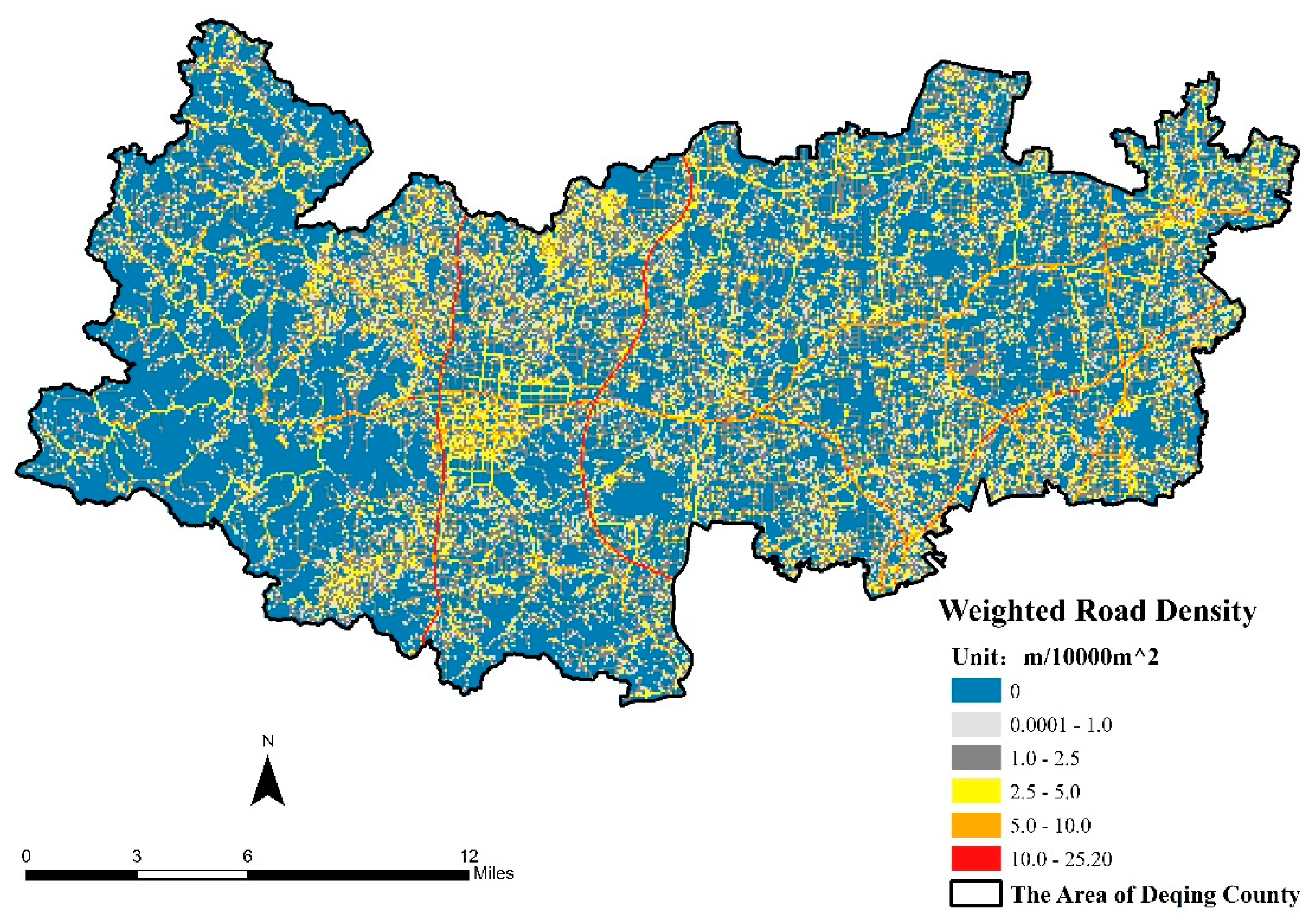
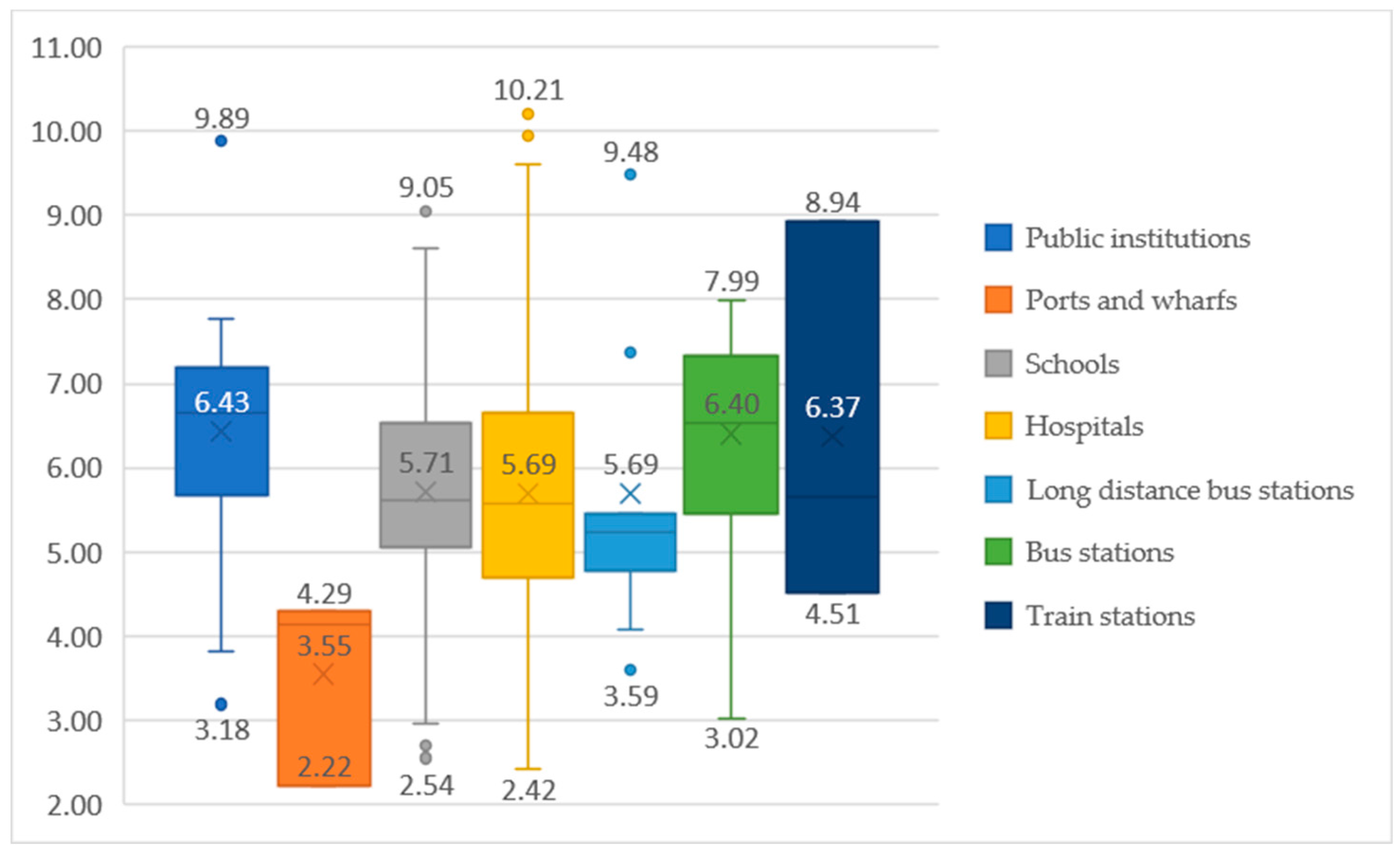
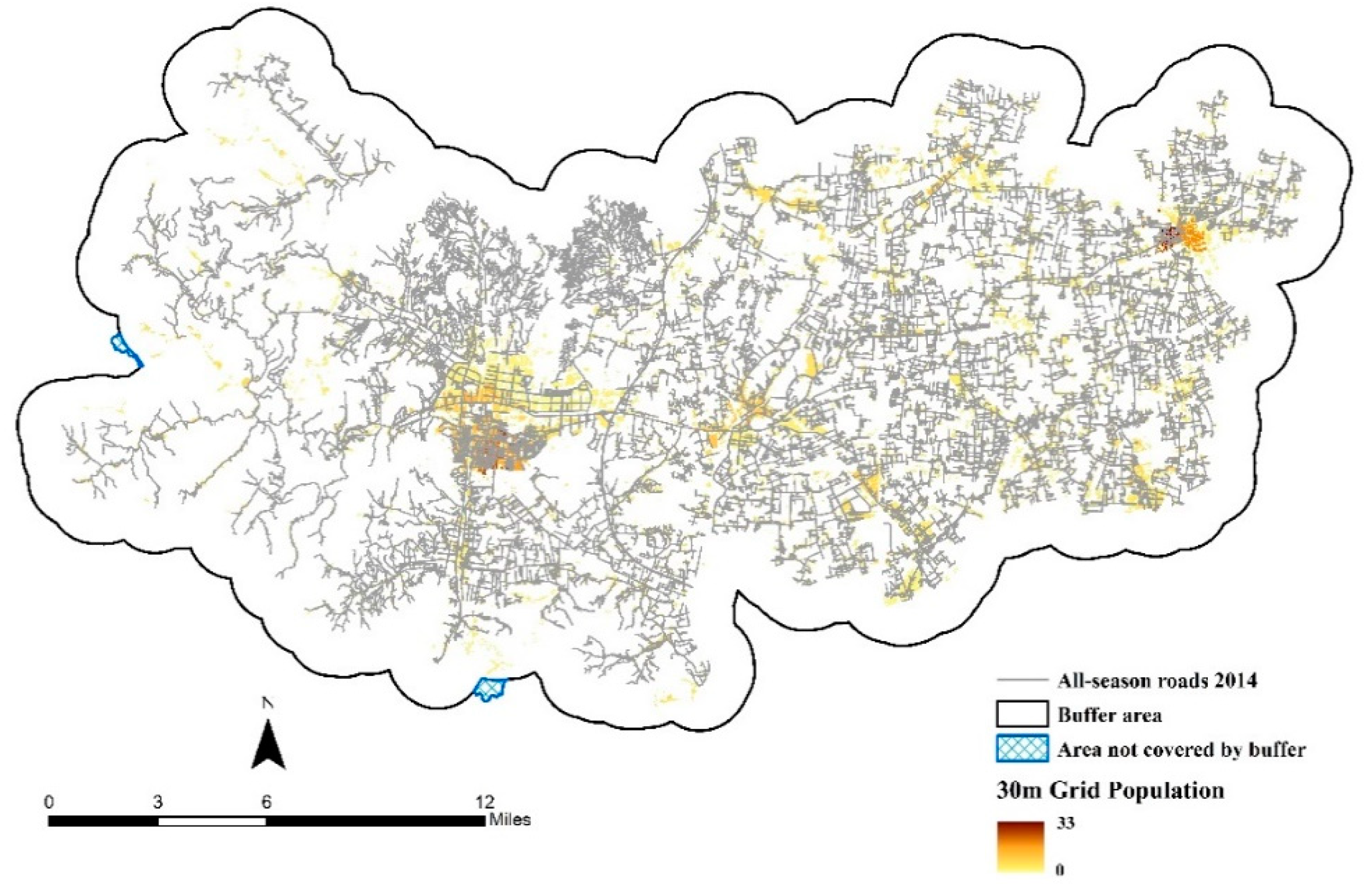

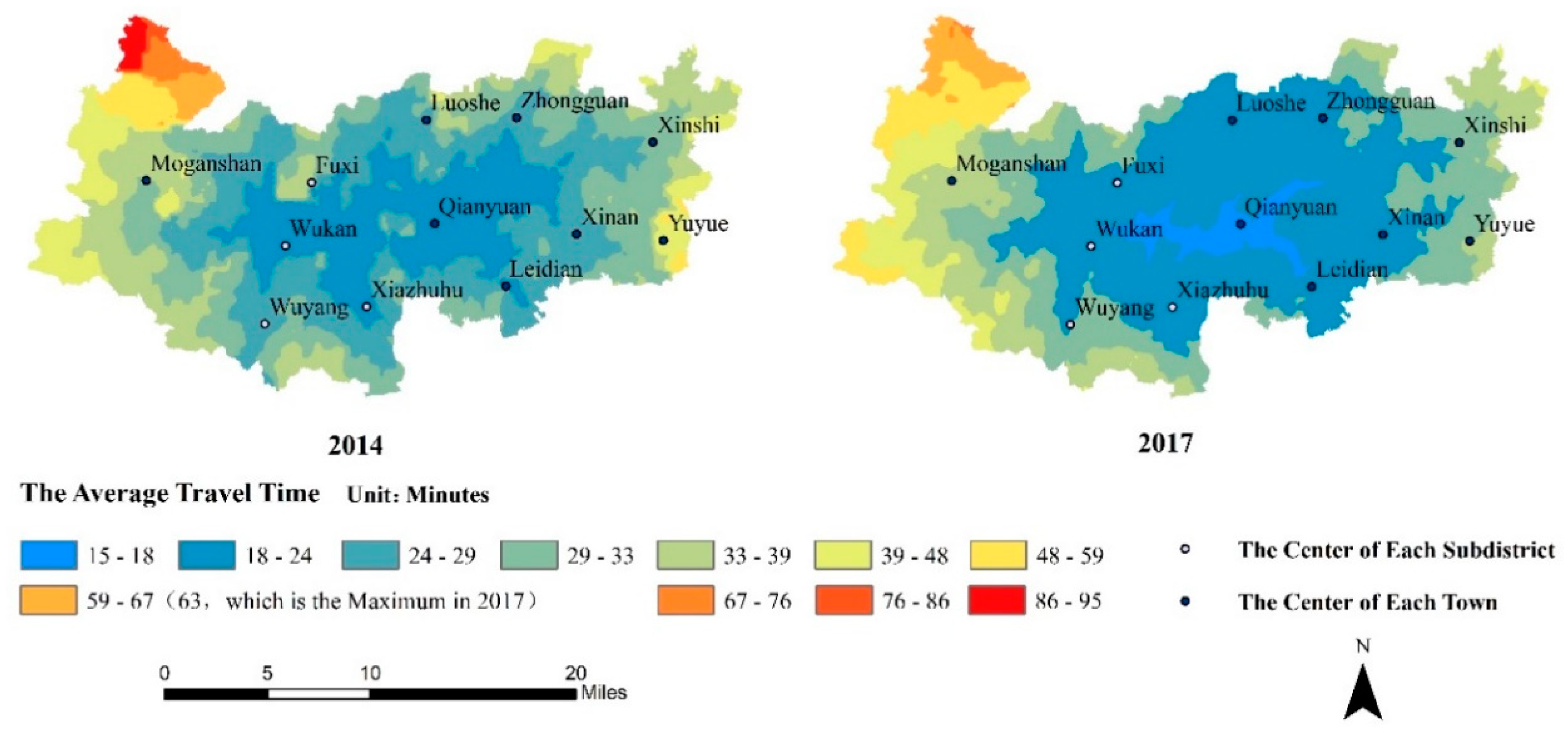
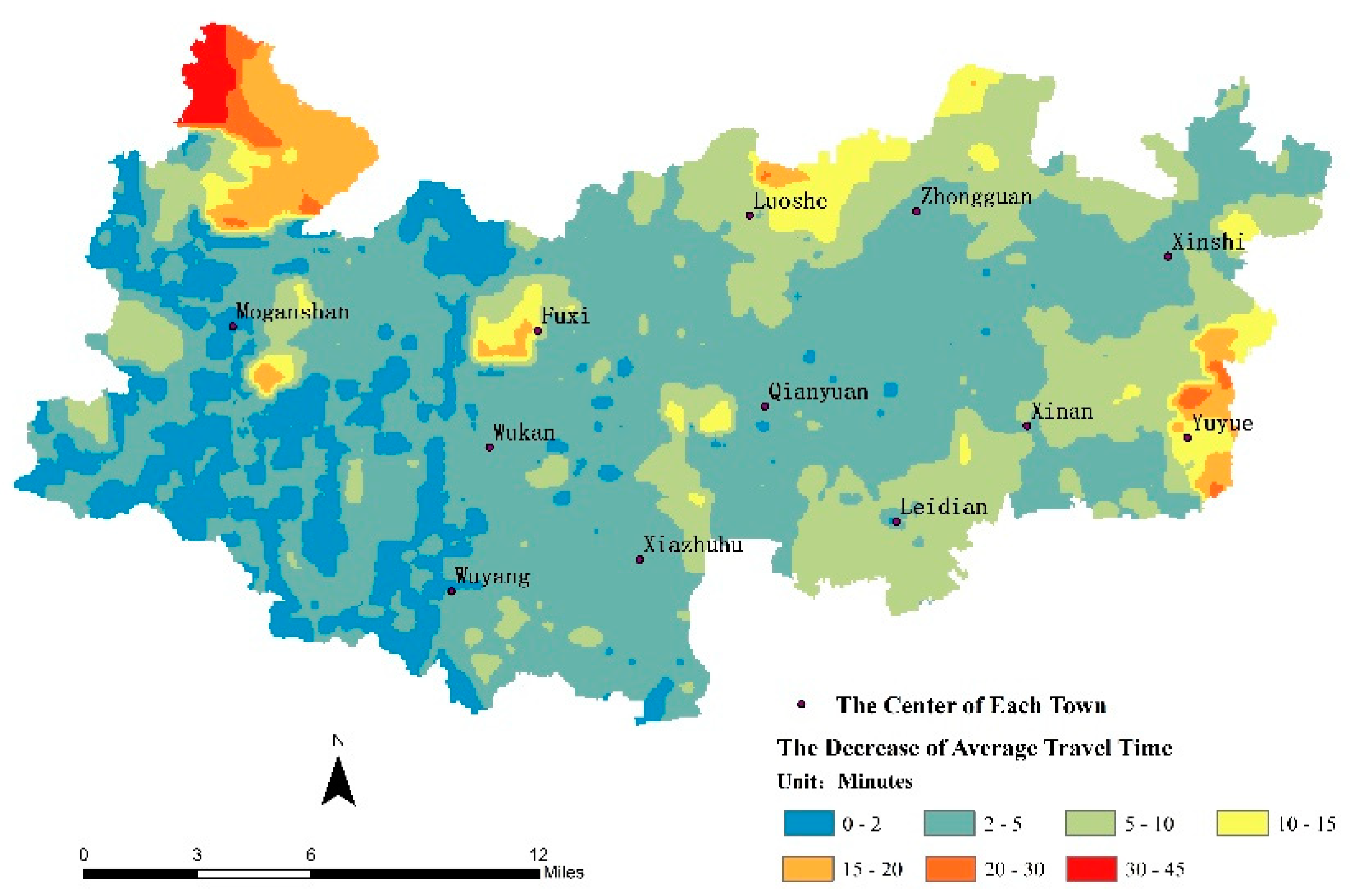



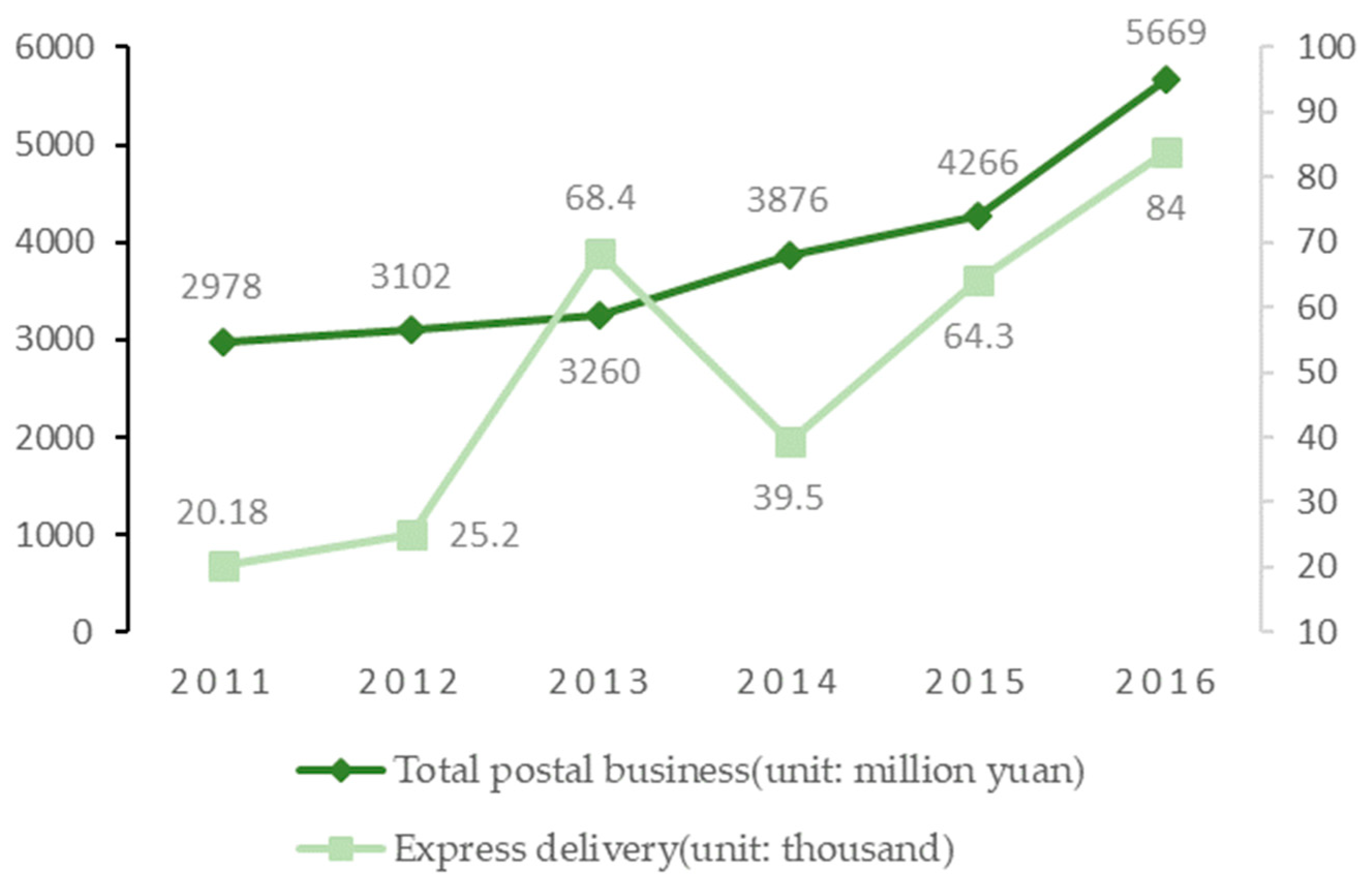
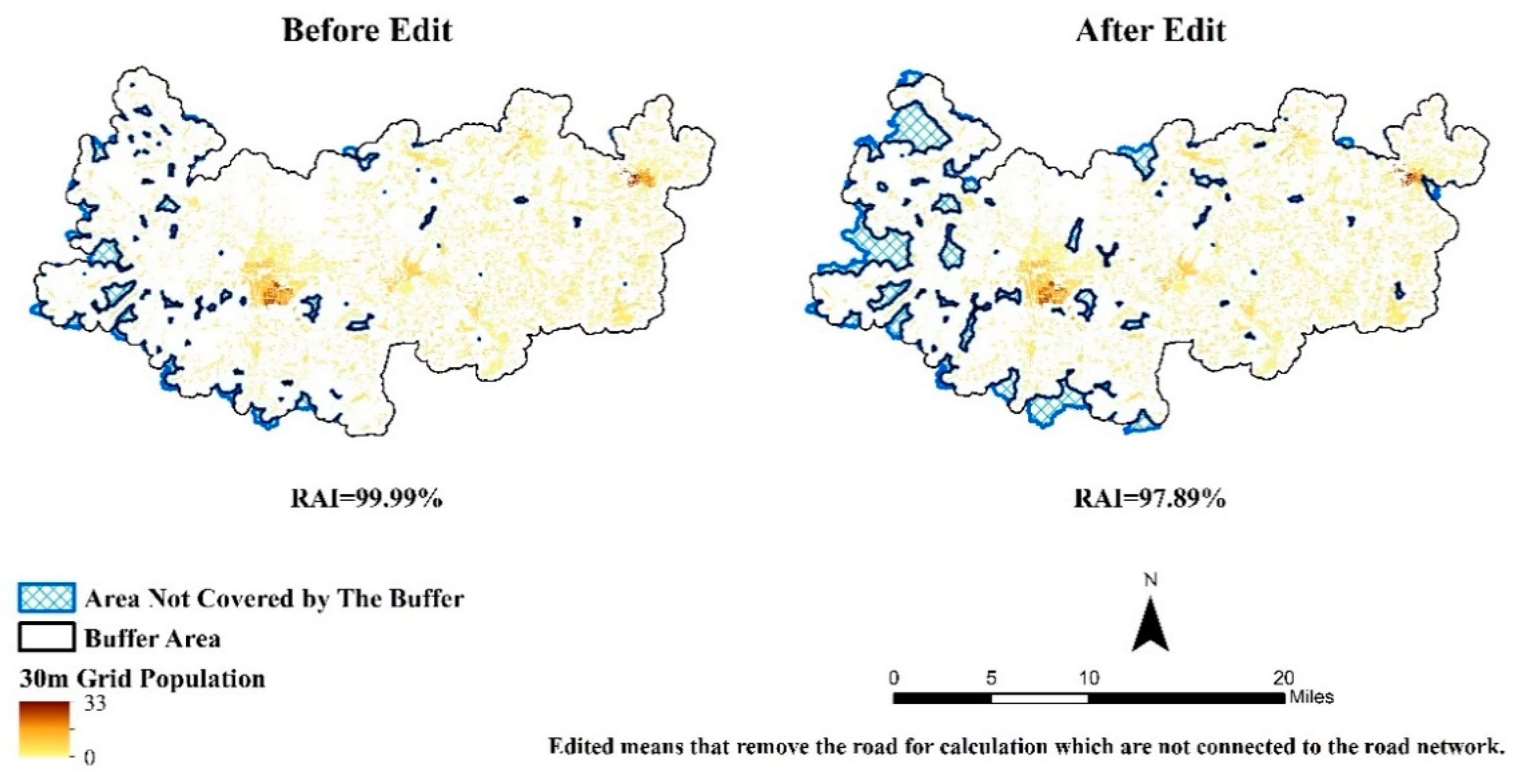
| Indicator Index | Sub-Indicator Index | Indicator Name |
|---|---|---|
| II1 | II1.a | Road Density (RD) |
| II1.b | Resident Access Index (RAI) | |
| II1.c | Accessibility (Average Travel Time- ATM) | |
| II2 | II2.a | Passenger and freight volumes, by mode of transport (PFV) |
| II2.b | Total Postal Business (TPB) |
| Road Grade | State Road | Provincial Road | County Road | Township Road | Urban Road or Road below Township Grade |
|---|---|---|---|---|---|
| Code | G | S | X | Y | Q |
| Weight | 0.4 | 0.21 | 0.18 | 0.13 | 0.08 |
| Number | Data | Data Source |
|---|---|---|
| 1 | Road | The road data comes from the Deqing County Transportation Management Department. It is a vector data, which contains the level of the road. |
| 2 | Population | It is calculated. The residential coverage of all residents will be extracted from the surface coverage data obtained from the Deqing County Geographic Information Center, and then the 30 m grid will be used to divide the residential area. Finally, the census obtained from the Deqing County Statistics Bureau will be based on the housing level in the land use data. The data is distributed to the surface coverage data according to the location. In this way, the 30 m grid population density data can be generated. |
| 3 | Passenger and freight volumes | These data were obtained from the Deqing County Statistical Yearbook published by the Deqing County Bureau of Statistics. |
| 4 | Total postal business |
| Average Travel Time | 2014 | 2017 | Reduced Value |
|---|---|---|---|
| Min | 18′06″ | 1′42″ | 2′24″ |
| Max | 94′47″ | 62′58″ | 31′49″ |
| Average | 31′42″ | 26′31″ | 5′11″ |
| Standard deviation | 626.31 | 444.56 | 181.75 |
| Problem | Dependence on Urban Rural Boundary Data During Calculation | Take into Account Urban and Rural Population | Show more Details and Spatial Distribution of Road Construction | Reflect the Impact of Transportation Infrastructure on Economic Development and People’s Lives |
|---|---|---|---|---|
| SDG indicator 9.1.1 and 9.1.2 | More | No | No | Incomplete |
| Improved indicator system | Less | Yes | Yes | More complete |
© 2019 by the authors. Licensee MDPI, Basel, Switzerland. This article is an open access article distributed under the terms and conditions of the Creative Commons Attribution (CC BY) license (http://creativecommons.org/licenses/by/4.0/).
Share and Cite
Xu, J.; Bai, J.; Chen, J. An Improved Indicator System for Evaluating the Progress of Sustainable Development Goals (SDGs) Sub-Target 9.1 in County Level. Sustainability 2019, 11, 4783. https://doi.org/10.3390/su11174783
Xu J, Bai J, Chen J. An Improved Indicator System for Evaluating the Progress of Sustainable Development Goals (SDGs) Sub-Target 9.1 in County Level. Sustainability. 2019; 11(17):4783. https://doi.org/10.3390/su11174783
Chicago/Turabian StyleXu, Jiacheng, Jianjun Bai, and Jun Chen. 2019. "An Improved Indicator System for Evaluating the Progress of Sustainable Development Goals (SDGs) Sub-Target 9.1 in County Level" Sustainability 11, no. 17: 4783. https://doi.org/10.3390/su11174783




